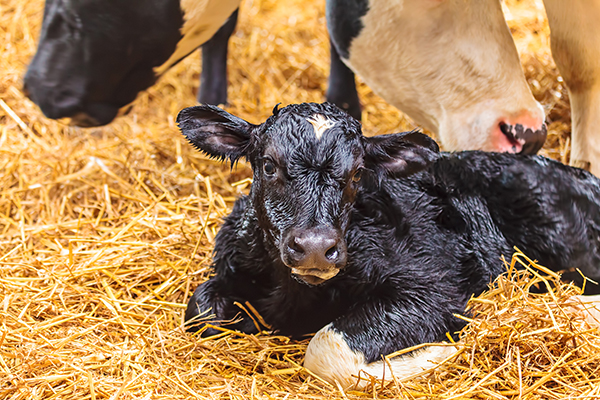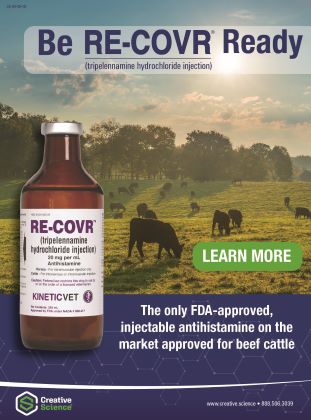Calf Diarrhea (Scours) in Dairy Calves – Prevention and Treatment

By Heather Smith Thomas
Many pathogens can cause scours in young calves. Intestinal infection and diarrhea can be due to certain kinds of bacteria, viruses or protozoa. Whether calves get sick is often related to multiple factors including exposure (contact with pathogens), level of immunity, and stress (such as bad weather–not enough protection from cold and wet or heat)—which can hinder the immune system.
Dr. Pete Erickson, Professor of Dairy Management and Extension Dairy Specialist, University of New Hampshire, says that prevention means making sure the cow calves in a clean, dry place. Second, dip the navel of the newborn calf. Even though it’s not directly related to scours, you don’t want the calf to get an infection like navel ill or joint ill. It’s best to use 7% tincture of iodine, and not teat dip iodine, though there are also some commercial navel dips. You want the navel to dry up quickly.
It’s also crucial to make sure the calf gets an adequate amount of high-quality colostrum soon after birth. “If you are unsure about the cow’s ability to make good colostrum or you have some frozen colostrum on hand and the cow is calving, you should thaw it while she’s calving, and make sure it is good quality. Good colostrum is much better than 50 grams per liter of IgG in a commercial colostrum supplement,” he says.
“You can easily check colostrum quality with a colostrometer. The challenge with that is that the colostrum has to be room temperature to check it (not cold or frozen). You can check it before you freeze it, or check it right out of the cow. An easier way to check it is to use a Brix refractometer or a digital refractometer. Good colostrum will be above 22% using this method,” says Erickson.
Recommendations are to give at least a gallon of good colostrum within the first 12 hours, either via suckling (the cow or a nipple bottle) or by tube. “You need to get at least 2/3 of that gallon into the calf immediately after birth, and the other 1/3 gallon within the next 6 hours,” he says.
The calf should be in a clean, dry pen or hutch, out of any drafts. “Many dairy farms still use hutches but around here we are starting to see more group pens. I am not a huge fan; group pens can work, but they take a different type of management. Many of those group pens are on automatic feeders.” For young calves you want to make sure they are fed on schedule and don’t have much exposure to pathogens.
“A clean dry hutch is a good environment, and calves can soon be on a starter grain. I like a coarse starter, not pelleted, though some big farms use pelleted starter. If you have to use pelleted starter, also provide some really good quality chopped grass hay and mix it with the starter,” he says.
It’s also important to provide free-choice water. “In winter, water may freeze so make sure you get some water into them after they drink their milk. When we feed high-protein milk replacers, it is imperative to provide water. Even though the milk replacer contains a lot of liquid, the minerals and nitrogen in those milk replacers can cause dehydration. These calves need additional water. The milk or milk replacer goes into a different stomach—the abomasum—whereas water goes directly into the rumen. This has a different effect and you also want rumen development.”
Some farms vaccinate their calves. It’s common on day one to give certain vaccinations and this is something you should discuss with your own herd health veterinarian who knows your operation. Sometimes diarrhea is caused by rotavirus or coronavirus, but a lot of this can be prevented by vaccination. If the cow is vaccinated ahead of calving with a “scours prevention” vaccine containing rotavirus, coronavirus and E. coli, she will have antibodies for these diseases in her colostrum. Some dairies vaccinate the calves at birth.
The first “vaccine” the calf receives is colostrum. This is the best insurance against illness and sets a heifer calf up for success all the way down the road until she becomes a cow. “There is some new data that indicates that the amount of colostrum the calf gets will actually translate into her level of milk production later. She does better for the rest of her life,” says Erickson.
If a calf gets diarrhea, there could be various factors involved. “Lack of sanitation is often to blame. A major cause of diarrhea in calves is coccidiosis. They won’t show diarrhea until they are at least 3 weeks old because the life cycle of this protozoan takes that long to damage the intestine. The calf might be exposed shortly after birth and then have diarrhea 3 to 4 weeks later,” says Erickson.
The oocysts are passed in feces and since all adult cattle shed some oocysts, manure is the main source of exposure for calves. “Most dairy farms will have coccidia on the farm. The only way to get around that is to do your best to keep things clean, diligently cleaning the hutches, the calf buckets, etc. You should also feed some type of anti-coccidal product either in the calf starter or preferably in the milk replacer. There are many different kinds, but any type of anti-coccidia will help prevent this infection and gut damage,” he says.
“One thing we have very little control over is cryptosporidiosis. It will manifest a little later after birth, like coccidiosis, but the incubation is shorter; you will see it sooner than coccidiosis. There is no vaccine for this and no adequate preventative treatment. The only really good defense is cleanliness,” he says.
“One thing we’ve been looking at here is cleanliness of calf pails. The plastic pails that most people use are often utilized to provide water, milk, starter, etc. They tend to get scratched and pitted, with worn surfaces where pathogens can cling and hide. We are looking at some ways to check this. There is an ATP meter that costs a lot of money but we can do a scrape of those pails and see where the ATP is—which would be an indicator of bacteria. When you start seeing lines and pits in those buckets it is time to get new ones because there is nothing you can do to get them clean enough,” he says.
It also makes a difference in how they are dried, after being cleaned. “Dry them on a rack so all the water drains out. Plastic has a way of holding moisture and it doesn’t dry very well, so you want to flip them over. You don’t want them on top of each other, but placed in a way they can drain. Ideally, you could use stainless steel buckets because they are much easier to keep clean, but they are also expensive.”
Cleaning out all bedding regularly is also important. “When using calf hutches, I like them to be up on some kind of earth or gravel bed so that urine and feces will drain away. I don’t like calf hutches on concrete or asphalt because there is no way for moisture to drain out and it will increase your labor, to clean them,” says Erickson.
“Clean the hutches as best you can. Sun is a great detoxifier after you remove the bedding. I have been on farms where they tell me they cleaned the sides of the hutches, but the bottom needs it most,” he says.
“It all starts with the cow giving birth in a clean place, but you can still run into situations in which the calf comes in contact with contamination, especially with twins. Often the first one will come out in normal position and the second one will be backward. As a backward calf comes out, often that calf gets a mouthful of meconium (if the calf defecated during the stress of birth) or cow feces and this can set the stage for illness, as well. You can’t always prevent this, but if you start with the cow in a nice clean place, it can make a difference,” he says.
Some cases of diarrhea are not caused by gut infections, but nutritional factors. These calves don’t need antimicrobial treatment. Look closely at the calves and check for signs of illness like droopy ears, dullness, etc. If the calf is still bright and alert and simply has loose feces, it’s probably nutritional scours. “This often happens when we feed a lot of milk. This isn’t something you need to treat, but just keep an eye on that calf to make sure she doesn’t get worse. If the calf is spry and acting normal, it’s probably not an issue,” he says.
“On the other hand if you see blood in the feces or stinky, grey stool or really watery diarrhea (the calf losing a lot of fluid and electrolytes and becoming dehydrated) you need to possibly treat the calf, or at least replace the fluid being lost.
TREATMENT – Whenever the calf is losing too much fluid, you need to replace it, to combat dehydration. Regardless of cause, supportive care with fluid and electrolytes is what the calf needs most. You might need your veterinarian to help determine whether the diarrhea is caused by nutrition or infection and whether additional treatment is needed or not. “Unless you are an organic dairy, I think it’s wise to give every calf medication to prevent coccidiosis, as insurance against that pathogen. Unless you have a new dairy, starting on new ground, there will be coccidia on your farm,” says Erickson.
Derek Foster DVM, PhD, DACVIM (Associate Professor of Ruminant Medicine, North Carolina State College of Veterinary Medicine) says the mainstay of treatment is fluid therapy. “For the vast majority of sick calves, it can be oral fluids, especially if they are not yet too dehydrated. My rule of thumb is that as long as the calf can get up and stand, and still has a suckle reflex, we can administer oral fluids; that calf doesn’t need intravenous fluids,” he says.
“Our recommendation for a calf with diarrhea is to provide at least 2 liters of fluids daily, in addition to whatever milk the calf is drinking. If the calf is bright and still wants to suck a bottle, hopefully 2 liters of additional fluid and electrolytes should correct the dehydration, along with the milk,” he says. In years past, veterinarians recommended holding calves off milk for 24 hours when calves had diarrhea, simply feeding electrolyte solutions, but today this is no longer advised.
“The old philosophy was that continuing to feed milk to a calf with diarrhea could make the diarrhea worse, but recent research suggests that milk doesn’t make diarrhea worse. It helps the calf maintain body weight while recovering. The calves we hold off milk tend to lose weight. We prefer to keep them on milk as long as they are up and able to suckle,” says Foster.
The oral electrolyte solution should contain the necessary electrolytes (sodium, chloride and potassium) in proper balance, plus an alkalizing agent—which is often bicarbonate. “If the calf is on milk we prefer to use an electrolyte that has an alkalizing agent other than bicarbonate. We need an alkalizing agent, but unfortunately there are some products that don’t contain an alkalizing agent. Since the blood pH in these calves is often low, we need to do something about that, with an appropriate electrolyte that will help correct their blood pH,” he says.
If the calf is still getting milk, bicarbonate interferes with digestion of milk. You can use a bicarbonate, but not at the same time the calf is receiving milk. “There are some products that contain acetate as the alkalizing agent instead of bicarbonate, so that’s a preferred ingredient for a calf that’s also drinking milk at the same time,” he says.
“For most cases of diarrhea, oral electrolytes once a day in addition to the milk they are drinking be enough to keep up with their fluid losses, providing the electrolytes they need, and helps rehydrate them,” says Foster.
Serious cases where the calf is weak, but not yet to the point of needing IV fluids, electrolytes and oral fluids should be administered more frequently, preferably once every 8 hours. “If the calf is too weak to stand, however, IV fluids and glucose will be needed because the blood sugar has dropped too low. Some of those calves will also need antibiotics. In general we try to stay away from treating routine diarrhea with antibiotics because supportive care is often all the calf needs. As long as we can keep them hydrated their immune system can take care of the pathogen—which is often a virus (rotavirus or coronavirus) or a protozoa (like cryptosporidium or coccidiosis),” says Foster. In these situations an antibiotic won’t help; the calf simply needs supportive care.
Replacing the fluid and keeping the calf from becoming dehydrated is the most important thing. “It’s a combination of making sure the calf has enough fluids, plus the electrolytes, since fluid cannot be absorbed without the proper electrolytes. Sodium is critical for absorption of water. Amino acids and glucose also increase the absorption of sodium, which in turn helps increase absorption of water. All these things work together to rehydrate the calf,” explains Foster.
An electrolyte product should be mixed with the appropriate amount of water to ensure that the calf gets the right amount of sodium. “If there is inadequate water the calf ends up with too much sodium and this can also be a problem. These things need to be in balance. It’s also important that the calf receive something to help correct its blood pH if it’s a little acidotic. Unless we are doing bloodwork on these calves, we don’t really know how acidotic they are, and we are guessing. Most of them are somewhat acidotic and we need to give bicarbonate or acetate. There are some good commercial products to have on hand if you need them,” he says.
The earlier you treat the calf, the quicker it will bounce back, and the fewer treatments needed. “If we can reverse the dehydration before the calf needs IV fluids, and keep it hydrated during the diarrhea episode, most of the time we can avoid having to resort to more intensive treatment,” says Foster.
Fluid and electrolytes can be administered via esophageal probe. The calf should be given fluids until it is strong again and no longer dehydrated. “The best way to assess how dehydrated a calf is (besides how depressed it is and whether it is willing to suckle) is by checking the eyes. As a calf gets more dehydrated, the eyes tend to sink back in the head. We assess the gap between the eyeball and the inside corner of the eye. In a normal calf, the inside corner, eyelid, third eyelid and eyeball should all be together and touching. As the calf becomes dehydrated the eye starts to recess back into the head (the surrounding tissues are short on fluid) and there’s a gap. The bigger that gap, the more dehydrated the calf; this is a rough gage to determine whether a calf is mildly dehydrated or severely dehydrated. This helps us decide if we can get by with routine treatment with 2 quarts of fluids once a day or if we need to give oral fluids more frequently, or need to give IV fluids,” says Foster.




